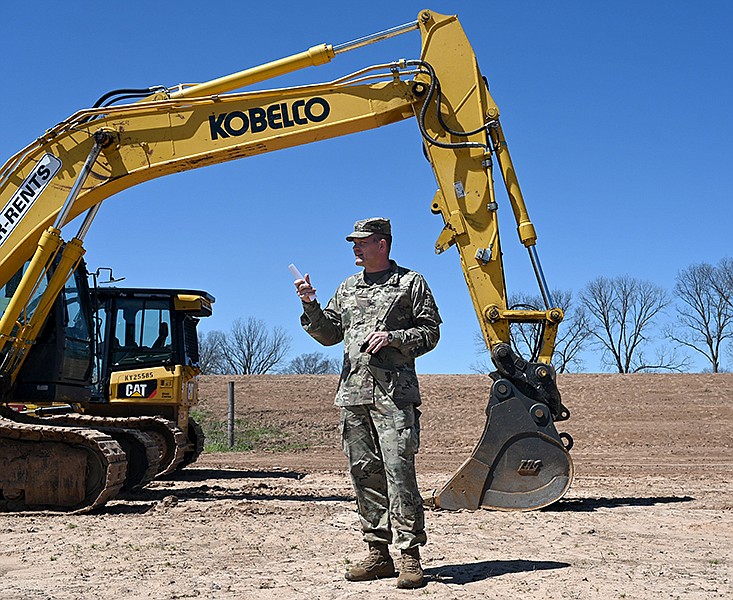CONWAY -- Repairs to levees that sustained heavy damage during historic flooding of the Arkansas River in the spring of 2019 are near completion, the U.S. Army Corps of Engineers announced Monday.
The levees, one located in Faulkner County and another in nearby Perry County, surround Conway and a number of smaller communities, including Toad Suck and Perryville. The levee in Faulkner County, known as the Lollie Levee, was nearly breached by rising waters from the Arkansas River during the floods that took place in May and June of 2019.
Brad Clark, the Corps' project manager for the Faulkner County levee, said that levee was not fully breached because water speeds were slower. An airport, homes, farms and water treatment plant could have been flooded had the levee completely failed, Clark said.
With 19 breaches, the other levee system in Perry County sustained significant damage from the waters. Repairs to that levee are expected to be complete this summer, said Col. Eric Noe, district engineer and commander of the U.S. Army Corps of Engineers Little Rock District.
The U.S. Army Corps of Engineers coordinated the repairs with local levee boards. The Corps organized a tour of the levees Monday for reporters, local officials and members of the construction and Corps' engineering teams working on their repairs.
An estimated 1,500 to 2,000 homes were flooded along the Arkansas River system between May and June 2019, Noe said.
Mobile homes destroyed by the waters still littered the sides of one road leading to a portion of the Perry County levee.
The 2019 floods, caused by early snowmelt in the Rocky Mountains and record rainfall from stalled weather systems over the Midwest, were among the costliest natural disasters in the state's history.
On May 24, 2019, Gov. Asa Hutchinson declared a state of emergency, dispatching the Arkansas National Guard to western parts of the state in advance of river crests there. The Red Cross opened a shelter in Fort Smith, and other cities also opened emergency shelters.
High water records were broken along the Arkansas River, including in Conway County where a previous record had been set during the catastrophic Mississippi River flood of 1927, according to the Encyclopedia of Arkansas.
"The 2019 flood event created an incredible amount of water that came into the Arkansas River," Noe said. "It created a lot of threat to our neighbors and our fellow citizens who live out here and who work behind these levees and similar levees up and down the system."
"It caused a lot of damage," he said.
The cost of the repairs is about $1 million for each levee, with funding from mostly federal and some state revenue.
The levees are part of the U.S. Army Corps of Engineers Rehabilitation Inspection Program. Under the program, the Corps regularly inspects flood-prevention infrastructure, such as levees, and provides much of the funding needed to repair such infrastructure in the event of a natural disaster, like the 2019 floods.
The infrastructure can be both federally and nonfederally constructed. Many of the levees in Arkansas are at least 70 years old, constructed during other historic flooding that took place when the Mississippi River flooded in 1920s and 1930s, Noe said.
Historically, local levee boards manage the upkeep of the infrastructure.
After the 2019 floods, the Corps realized that many of the boards were inactive around the state and made efforts to mobilize communities to reinstate them and to encourage them to upgrade levee systems to qualify for the Rehabilitation Inspection Program.
"Some of the levee boards, it was like, 'Where is this board? Where did it go?'" he said. "Some levee boards the presidents had actually died, and the boards had not been revitalized in quite some time, much less understood the requirements to get into the Corps' program."
"That was an interesting silver lining in the cloud of 2019," Noe said. "I think [the flooding] helped revitalize a lot of focus on flood mitigation and prevention."
The majority of the levees in Arkansas are not a part of the program, Noe said, largely because of the amount of money needed to repair levees so that they qualify for the program.
"We roughly estimate $10 million a mile to bring some of our agricultural levees up to the standards needed to enter the program," Noe said. "That is why a lot of folks can't afford it, but the investment is worth it because any subsequent damage, the federal government picks up at least 80 percent of the tab once you're in the program."
Repairs to the Faulkner and Perry county levees took time to commence because landowners surrounding the infrastructure needed to be contacted and other procedures had to be put in place to start construction.
Reconstruction of the Faulkner County levee, which is nearly completed, began in December 2020.
The Perry County levee, which has breaches that destroyed entire portions of the structure, would require an emergency response should a catastrophic rain event occur before repairs are finished, Noe said.
"At times, you just cannot build enough protection to combat against Mother Nature," Noe said. "It is just not possible and not economically feasible."
"Half the counties in Arkansas are going to lose people, and half are going to gain people," he said. "We think those are all predominantly going to be on the waterways, so levees like this become more and more important to preserve the changing demographics and the communities behind them."
"Mother Nature will strike again," Noe said. "How much? When? No one knows."
